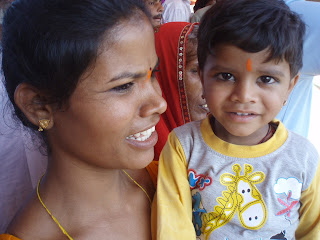Pushkar is set in a shallow valley with 500 temples, a strict Hindu town – eggs, alcohol and meat are banned. The festival is full swing and the town pulsates with activity. A roar of echoes through the shallow valley and across the lake and back again. Noisy chatter, praying, chanting, singing, loudspeaker announcements and car horns fill the air. Hundreds of people march from one side of the town to the other, not quite clear of their purpose.
Pilgrims bustle to the ghats along the lake, hurried along by boy scouts with sticks, westerners mingling around slyly photographing the strange spectacle along with upper class Mumbairans as foreign as us to this scene. I find myself in a small temple by the lake and a group of old men beckon me over, I sit a while and we study each other curiously. Under a shaded tree by the lake groups of dreadlocked Indian holy men sit smoking weed with groups of dreadlocked travellers.
Ragged children with gypsy mothers are sent out for a profitable day at the mela, each carrying their silver metal tin, ready for the day's takings. They join the begging queue with the saddhus in their dirty white cloths who have recently descended from the Himalayas for their seasonal migration down to the desert and Ganga plains for the winter mela season.
Desert nomads from across Rajasthan gather at the mela. Tall barefooted men in orange and white cloths baring the wrinkles of a lifetime in the desert, proudly sporting bejewelled ears and an array of colourful turbans – a vibrant range of red, multicoloured and luminous green or pink. They walk separately from the women. Tribal wives bustle around the markets, haggling with traders for pans and cloths; with strong features, eyes of deep ivy green or milky hazel, large exotic gold nose piercings and bangles up to the shoulders, like Amazonian tribes.
Flocks of hawkers from across the region are out in force. I fall victim to a gypsy who hennas me, a dispute ensues and we are surrounded by a pack of vampires smelling a bloody drama.
Every evening a noisy procession phlitters through the town. Wedding parties with hijras tagging along, hiding their faces but shooting secret coy looks from under brown shawls, spying out from their secret worlds. Then come the tall white Hare Krishna men with North American accents, shaved heads and random tufts of hair, irritating with their bombastic insistence we contribute money to their party.
In the stadium there are various sports and activities happening. I see a show combining snake charming and the simulated beheading of a young boy, a strange boy sport where they push and shove each other – a cross between rugby (minus the ball) and British bulldogs and the musical chairs – Indian style with people pacing slowly, edging round the ring despite the pushy insistent umpires hurrying them.
The last day saw a the disorganised closing ceremony with random spurts of “cultural activity”, wacky camel races, music and dancing, a tug-o-war between locals and foreigners and then a cattle show where the bulls run amok stampeding into the crowd – unplanned I think. The thousands of excited pilgrims then rushed off to bathe in the holy waters of Pushkar's lake, Pushkar Sarovar, linked to Brahma – the creator God. Bathing in the sacred lake purifies all your sins, particularly on Kartik Poornima – this day of the year coinciding with the full moon. Like Varanasi I decline the holy dip in dubious looking waters.









































































